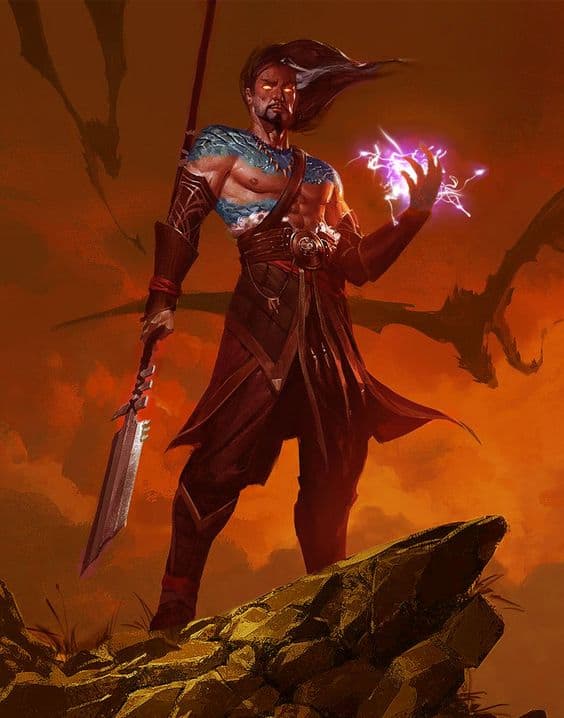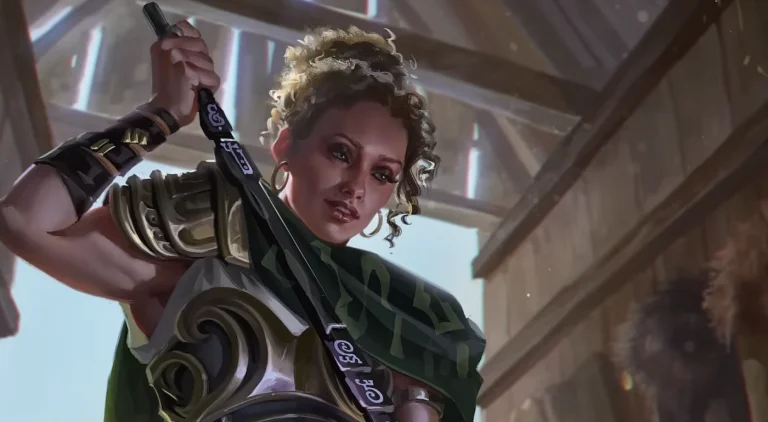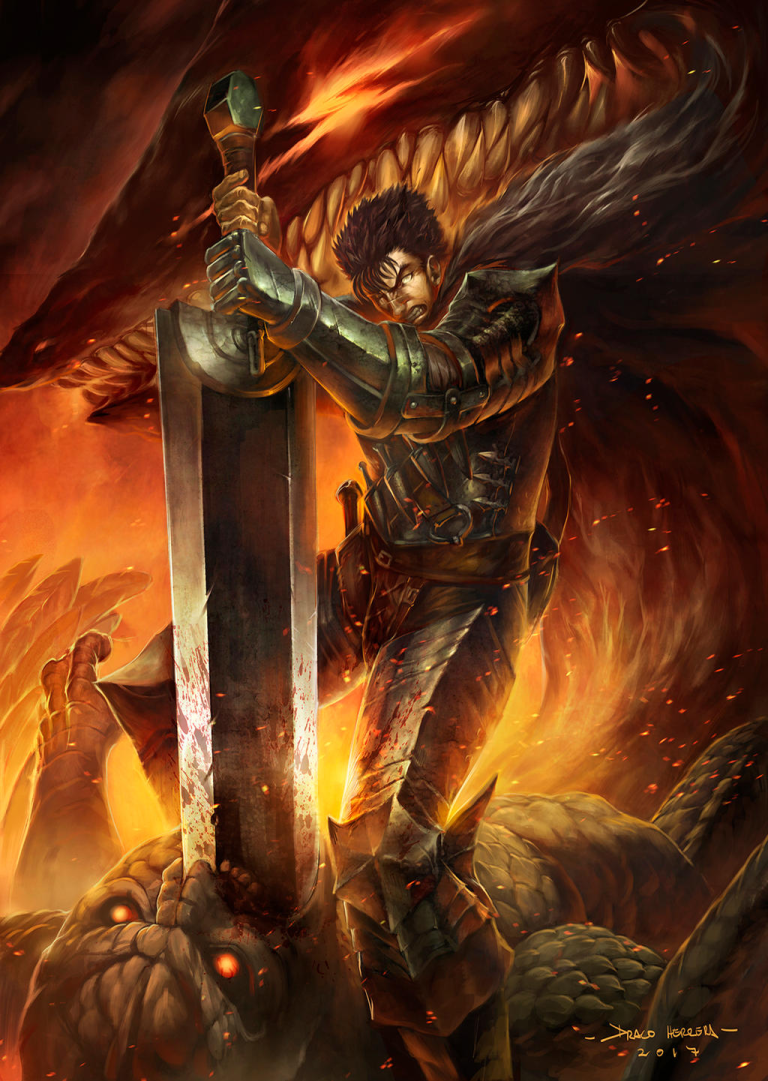D&D 5e: Draconic Bloodline Sorcerer Guide

D&D 5e: Draconic Bloodline Sorcerer Guide
Intro/Role in Party
Striding into battle wreathed in elemental fury, Sorcerers of the Draconic Bloodline draw from the storied heritage, and temperamental rage, of the source of their powers.
Naturally harder to kill than a lot of their peers, Dragon blooded Sorcerers make for aggressive spellcasters, dealing more damage when casting spells that they have an affinity for, before taking wing and terrifying their enemies.
Epic
Good
Meh
Bad
The Draconic Bloodline Sorcerer subclass is found in the Player’s Handbook. Click here to pick up your own copy of the Player’s Handbook!
Draconic Bloodline Features
When the Draconic Bloodline takes the first level in the subclass, they have to choose their draconic heritage, ie, what type of dragon is responsible for the power in their blood. The type of dragon affects the elemental effects of some of your abilities, so it’s important to make a choice that’s useful for your party and the campaign you’re playing.
Dragon Speech: This ability doesn’t have an official name. But the Draconic Sorcerer learns to speak, read and write Draconic, and essentially gets Expertise on social checks against Dragons. Many campaigns don’t feature dragons particularly heavily, and the ones that do tend to have them as a rampaging villain.
If you know your campaign is going to have more dragons than usual, or you chat to your GM beforehand, this could go to green, purely on the social checks.
Draconic Resilience: The base AC of the Draconic Bloodline is 13+DEX, and they gain a small amount of bonus HP per level.
Any increase to the defense of one of the squishiest classes in the game is a good one, even if it’s as relatively minor as these bonuses. This can also help with multiclassing, especially into martial classes, something the Draconic Bloodline excels at.
Elemental Affinity: From level 6, Draconic Bloodline Sorcerers add their CHA modifier to one damage roll of any spell that shares the element of their draconic heritage.
The Draconic Bloodline can also spend one Sorcery point to gain resistance to their chosen element type for an hour without needing concentration, which is a very good deal considering Resist Elements would otherwise cost a 3rd level spell slot or 5 Sorcery points.
The effectiveness of this ability varies wildly depending on the element you chose. For example, the Sorcerer spell list has over 20 Fire spells, and lots of enemies deal fire damage.
However, there are less than 10 Acid spells in the Sorcerer’s repertoire, and far fewer monsters deal it as a damage type. (Slime types and enemies that swallow you, usually.)
There are ways around this (notably, the Transmuted Spell metamagic, which is excellent) but it still means that you’re fueling spells with sorcery points as well as spell slots.
Dragon Wings: At level 14, the Draconic Bloodline grows wings and takes off into the sky! Free, constant flight without any resource costs, that can be switched on and off is an incredibly powerful ability that narrowly misses out on being purple, for a couple of reasons.
1, the Sorcerer has been able to Fly using the spell since level 5, so this comes relatively late, and 2, at level 14, a lot of enemies have ways to attack at range, and flitting around casting spells puts a big target on your head.
Draconic Presence: At level 18, the Draconic Bloodline can tap into their dragon ancestry, gaining their own aura of draconic majesty. Or at least, that was the intent.
There’s no sugar coating it, this ability is bad, especially considering it’s the subclass’s capstone. As an action, it causes enemies within a generous range to have to make a WIS save or be charmed or feared (chosen when the ability is used) until the ability ends after 1 minute.
So what’s the bad? First, if an enemy passes the save, they are flat-out immune to the ability for 24 hours. Also, it’s a Wisdom save, which is a common save roll, and one many enemies have high bonuses in.
Second, the ability takes your concentration. Meaning that you’re doing this instead of casting spells. 9th level spells. All of which are vastly more powerful than an AOE fear.
Third, is the cost. Many subclasses with abilities just like this one gain a certain amount of uses per day for free. But for some reason, this costs 5 sorcery points. That’s an absurd price for the power on offer.
The most galling thing about this ability? It basically replicates the Fear spell, which every Sorcerer has had access to for 13 levels at this point, or the Dragon Fear feat, a Dragonborn racial feat that only costs one use of their breath weapon instead of a huge chunk of a vital resource.
Strengths
Sorcerers can be built to succeed in a wide variety of roles, but naturally lean towards either buffing and debuffing, or full on damage dealing. The Draconic Bloodline in particular seems like a natural blaster with bonus damage on spells, resistance to the elements they’re going to be throwing out, and extra HP to risk getting close enough to land a key cast.
The base abilities of the Sorcerer backed up with the increased toughness on offer that will help you stay standing, means that the Draconic Bloodline can also be a solid backline support character if built correctly. Using the Twin Spell metamagic to copy key buffs on two party members while staying just out of reach is a powerful strategy, and if the enemy looks your way, you’re more likely to be able to withstand what comes.
Lastly, the things that make the Draconic Sorcerer good make it a decent choice for multiclassing, especially with martial characters as a spellblade, who appreciate the extra HP and other defenses, leaving them far less squishy.
Weaknesses
Let’s get this out of the way. The biggest weakness of the Dragonic Bloodline Sorcerer is that it is genuinely weaker than many of the other Sorcerer subclasses.
Most of the things that this subclass wants to do are done better by other subclass options, and some of the ‘bonuses’ it offers are incredibly niche, or meaningless.
The gulf only grows wider when directly compared with the newest subclass options for the Sorcerer, all of which come with far more powerful subclass abilities and a suite of bonus spells, fixing one of the major issues of the Sorcerer base class; lack of spells known.
Despite their increased resilience, Draconic mages are also still surprisingly fragile against serious attacks. At all levels, a concerted effort by a big monster or equivalent boss level enemy will probably leave a Draconic Bloodline Sorcerer close to death, if it doesn’t drop them to 0HP instantly.
Finally, lacking in spells and meaningful subclass abilities leaves the Draconic Bloodline in a weird space where it wants to specialize to bring what power it does have to bear, but doing so can leave a character with very few things to do outside of piling on damage turn after turn, which can quickly become repetitive.
Best Race Options
Dragonborn: Do you know who already has a draconic heritage? A Dragonborn. The stat spread matches the Sorcerer’s needs, and every type of Dragonborn brings something useful.
Chromatic dragons can make themselves immune to their element of choice, allowing you to drop a fireball at your own feet and laugh amidst the flames. Gem Dragonborn gains a once-per-day fly speed and a psychic speaking ribbon ability. Metallic Dragonborn add save-or-suck abilities to their breath weapons, a useful panic button if enemies get too close.
Changeling: Part of the Draconic package is growing scales, making it hard to hide the fact that you’re a Sorcerer. The Changeling can shift its appearance at will, hiding the obvious tells and making it harder for your enemies to find you, (or your GM to metagame.) It can also be used to change your appearance for other reasons, like sneaking missions or imitating others.
Good stats, useful skill proficiencies, and some subsidiary benefits round out the race.
Dispater Tiefling: All Tieflings offer a CHA bonus, which is the most important thing to look for when choosing a race to build an effective Sorcerer, but Dispater in particular also offers +1 DEX, as well as a suite of useful once-per-day subterfuge spells.
Be aware that all Tieflings come with Fire Resistance baked in, which is especially good if your element isn’t fire, as it adds another defensive option against the most common elemental damage type.
Choosing the Right Skills
The Sorcerer as a class is limited in skill slots, normally only being able to choose 4 to 5 from their class, background, and race, and no natural way of gaining more.
That means it’s important to choose skills that are going to have the maximum impact. Perception is essential to almost every character, and the high CHA of the Sorcerer also means that they’re great at social skills like Persuasion and Deception.
If you can, look to the party to fill your remaining skill choices, or lean towards things that benefit your background. One or two knowledge skills, for example, can be handy to have and add a lot of flavor, especially Arcana, which covers magic and magical creatures. Dragons and spells. It’s what you do already.
Fitting Feats
Elemental Adept: The Elemental Adept feat lets your spells ignore resistance to an elemental damage type of your choosing, which would otherwise instantly cut your damage in half. Especially important for a class that focuses so heavily on a single damage type.
As a bonus, every damage dice of that element that rolls a 1 counts as a 2, a small damage increase that’s also insurance against the times you somehow roll five 1s out of 8 total dice.
Alert: The abilities of the Draconic Bloodline naturally lend themselves towards being a blaster. That means the ability to take the first turn and drop your highest level spell onto the enemies when they’re probably clumped together and without any defenses, is a big, big deal.
The supplementary benefits against being surprised are also useful, as is just going first in general.
Metamagic Adept: The Sorcerer doesn’t gain their third metamagic option until level 10, and it’s almost certain that one of your choices will be Transmuted Spell to shift elements to your bloodline choice. Two more Sorcery Points also means more metamagic or general spellcasting too, which is a solid benefit.
Optimal Backgrounds
Courtier: One of the best ways to get Persuasion. Insight is useful, as are the languages. Pick something exotic and invent a storied past for your sorcerer.
Charlatan: Two skills most Sorcerers will have the stats for, in Deception and Sleight of Hand, plus two sneaky tool kits. At the very least, you can talk with your GM about using Disguise Kit proficiency to hide your Dragonblood marks, so you can slip through crowds better.
Sailor: (Or Pirate) One of the few ways to get Perception from your background, a career on the oceans makes sense for certain Draconic heritages (storms call to you!) The flavor is great, Athletics is a commonly used skill, but you probably won’t have the stats to be good at it unless you’re multiclassing.
Multiclassing Options
Tempest Cleric: This build focuses on one big combo. At level 2, the Tempest Cleric can automatically deal maximum damage when casting a lightning or thunder spell using their Channel Divinity option. Draconic Soul can pick lightning as their element of choice for bonus damage, and the Transmuted Spell metamagic can change the damage type of any spell to lightning.
Putting this all together, from level 7 (Draconic Sorcerer 5, Tempest Cleric 2) it’s possible to drop a lightning flavored fireball that deals a flat 54 damage to everything in the area of effect. Taking the Elemental Adept feat prevents enemies from resisting any of the damage, and the key component, Chanel Divinity, comes back on a short rest.
The combo continues to scale as the class levels up and gains access to better spells and higher level slots. Ancillary benefits include armor and shield proficiency, as well as access to the Cleric spell list.
Hexblade Warlock: Two levels of Hexblade offers so much. Almost too much, as it’s the most common dip for every CHA-based class. Medium Armor, Shields, a melee weapon that hits and deals damage with CHA, spells, plus the Eldritch Blast cantrip, two invocations (use at least one to boost EB.)
The Draconic Bloodline already makes a character tougher than many other Sorcerers. Adding armor to the mix helps, as do two extra level 1 spell slots that can be refreshed on a short rest, and converted into Sorcery Points if they’ve not been used by then.
Ancients Paladin: The Sorcerer Paladin has been a staple multiclass since 5e landed, for good reason. It’s incredibly powerful, mixing good spellcasting from two solid lists, reasonable toughness, and the ability to fight in melee and cause obscene damage spikes with Smite after Smite, fueled by the increased spell slots Sorcerer levels bring.
So why is it green? Commitment. A Sorcadin takes a few levels to get rolling. In the mid-game, a character built this way will be a monster, but early levels can be slow. We would choose Oath of Ancients for the Paladin 7 aura that gives you and nearby party members resistance to spell damage, and the strong, flavorful spell list.
Would I recommend playing a Draconic Bloodline Sorcerer?
The unfortunate truth is that as 5e has matured and other subclasses have been published, the Draconic Bloodline Sorcerer was left behind a little. Things that seemed fine when the Player’s Handbook was first published are weak now, especially when directly compared with what other subclass options bring to the table, and some of the abilities were relatively underpowered even when the class was first published.
A Draconic Sorcerer can still be a useful, worthwhile character at the table, especially with smart spell choice and ability use. But when other party members start hitting mid to late game and their more powerful class abilities come into play, the Sorcerer might start channeling the traditional Dragon emotions of jealousy and avarice when they see what treasures they’re missing.
.









